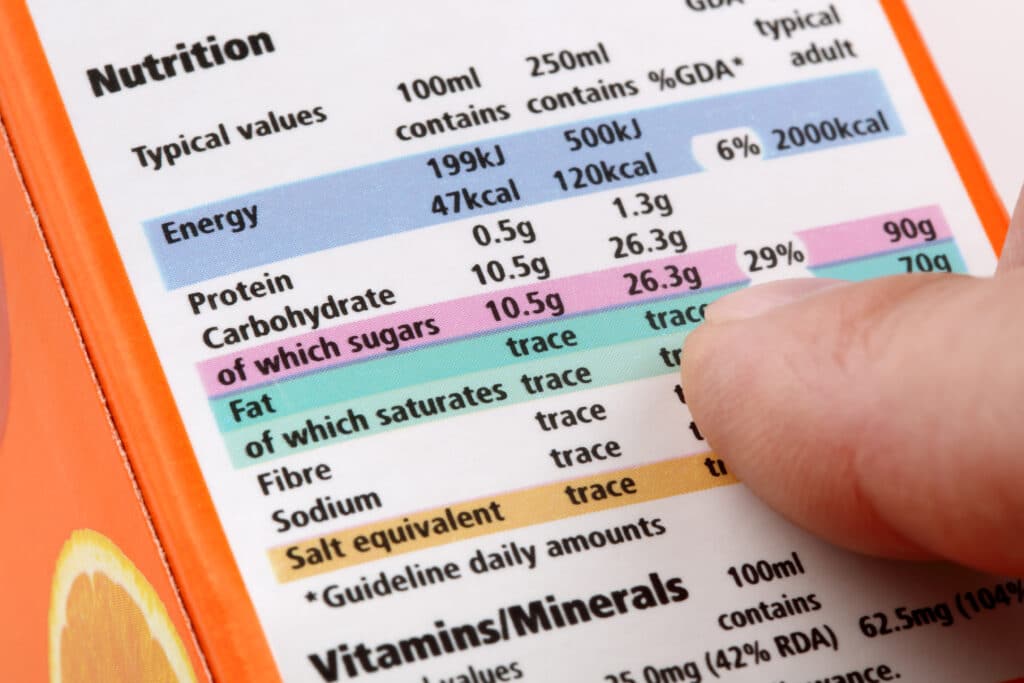When you’re deciding what to eat, understanding what’s in your food is essential. Reading nutrition labels provides valuable information to help you make informed choices about your meals. Here’s what you need to know about reading these labels and avoiding common mistakes.

Nutrition labels are not the easiest things to read. For many people, reading these labels is just not something they do. The labels on packaged food items are supposed to help us make better decisions when it comes to food. After all, it’s human nature to want convenience and speed. But, as with most things in life, you need the knowledge to succeed.
Nutrition labels are helpful for those who want to make healthier food choices. It is meant to give you all the information you need to make a wise decision about what you buy. It is a great way to find out the contents of food and can be an important tool in making healthy eating choices.
When you look at a nutrition label, it may seem like a lot of jumbled-up words, numbers, and confusing information. Most of us make food choices based on what the nutrition label says, but do you know how to read it? Nutrition labels can seem like a lot to take in. However, by learning a few simple facts, you can avoid making the common mistakes that people make when reading nutrition labels.
How Nutrition labels work
Many people ignore the nutrition labels on food, but if you look at them you will be shocked at what you see. The nutritional information that is on the back of your food is only the tip of the iceberg when it comes to the real nutritional value of the food.
The Nutrition Facts label is a requirement for all food products in the United States. The label is meant to make it easy for consumers to know what’s in their food and how that food will affect their health. The information on the label is meant to be an aid in making an informed decision about what you should eat. However, the FDA allows food manufacturers a great deal of freedom to format the Nutrition Facts label in a way that makes it most effective for their products. That means that the same basic information about a product may be presented in several different ways. This is where the problem comes into play. Food manufacturers can choose how they want to present the information on the nutrition facts label. The labels must be easy to read and understand, and they must be consistent with the requirements of the law to make it easier for consumers to compare similar products.

Following are the basic elements of any nutrition label:
- Serving size
- Servings per container
- Calories
- Total Fat.
- Saturated Fat
- Cholesterol
- Total Carbohydrate
- Dietary Fiber
- Sodium
- Potassium
- Sugar
- Protein
- Vitamin A
- Vitamin C
Why Nutrition Labels Are Misread
With the dramatic increase in health consciousness in America, the amount of information available to the consumer has also increased. One of the most important things to consider when purchasing food is the nutrition label. The facts are there. They are in plain sight for all to see — the caloric content, the number of grams of fat, the number of milligrams of sodium, etc. So then, why are consumers still misreading nutrition labels?

Nutrition labels are full of confusing terms and scientific jargon. They can contain a lot of information and are often very lengthy. The food industry uses this jargon to hide the true contents of the food, but consumers often misinterpret the information. Nutrition labels are also difficult to read because they don’t follow a standard format. The label only has to be in a format that is understandable to the consumer. The FDA does not hold the manufacturers of food products responsible for the accuracy of their labels. This means that products of the same type can have different labels. It also means that products can have the same labels even if they are not the same. You might be surprised by how many foods have little or no nutritional value.
Do you have questions? Contact us for answers.
Why reading nutrition labels is so important
It’s no secret that we’re often less than healthy eaters. We eat too much; we eat foods that aren’t very good for us. It’s no wonder that we have an obesity epidemic in the US. What we eat can make a difference in the quality of our life. While it might not seem like it, reading the nutrition labels is a very important step toward making sure that we get the best possible nutrition for our bodies.
Many people fail to realize the importance of nutrition labels. They are an important part of our daily lives, from the food we eat to the things we buy and they can be used to make better choices. If you’re getting ready to buy a specific product, make sure to check out the nutrition label before you purchase it. It can help you make a more informed decision and it might just help you live a healthier lifestyle! If you understand and read nutrition labels, you can figure out how much fat and other nutrients are in the foods and drinks you consume. As a result, you’re more likely to eat healthier.
Schedule a free 30-minute consultation to learn more.
Tips to help make it easier to read Nutrition labels

While you are perusing the local grocery store, you might find yourself staring at a shelf full of food products, trying to make sense of all of the nutrition facts and figures. This can be a daunting task for anyone, and it’s even more difficult for people who are trying to eat healthier. A lot of people are misinformed about what is healthy and what isn’t, which leads to many people buying foods they think are healthy but aren’t. If you want to eat healthier, you need to know how to read nutrition labels. So here are some important tips that can make it easier to read nutrition labels:
- The first place to look is the serving size. The nutrition facts are based on a single serving. Make sure you understand what a serving is. It’s not uncommon for deceptive packaging to list the entire contents, even though one serving size is often a fraction of that. The smaller the serving size, the more sugar, salt, sodium, and fat it contains.
- Find out how much of each ingredient you consume. Most times, the food product packaging includes ingredients such as flavorings, preservatives, etc. If you don’t recognize an ingredient, don’t eat it. The rule of thumb is to leave it out of your body if you don’t know what it is.
- Avoid too much-saturated fat.
- To lose weight, you should reduce the number of calories you eat; however, you also need to look at the macros. The term ‘macronutrients’ or macros is used to describe the three main nutrients your body needs: protein, carbs, and fat. These are the primary source of energy for your body. The ratio of these nutrients you should have in your diet depends on the goal of your fitness plan. If you’re looking to increase muscle mass, then it’s best to eat more protein and fat in your diet. If you are trying to lose fat or maintain a healthy weight, then you should eat more carbs and protein. Achieving a well-balanced diet is key to your health and fitness goals.
- Look at the amount of cholesterol in the food. Foods that are high in cholesterol can raise your blood cholesterol level.
- Avoid products with lots of added sugar. You want to stay away from anything that lists sugar as the first ingredient.
- If the food is a high-fat food, then your body has to work harder to digest it, so it will also take longer for your body to use the calories in the food. Many people assume that fat is bad, but that isn’t true. Working the right fats into your diet is essential to your weight loss goals.
- You should also look for foods with a lot of vitamins and minerals.
Food isn’t just about taste and enjoyment. It’s about keeping your body happy and healthy. If you know what to look for when reading nutrition labels and understand how to interpret the content, reading the labels should be easier. We hope that this post helped show you some of the many ways that you can improve your diet. Now that you know a little more about nutrition facts labels, we hope you never miss out on any critical information that could be hiding on those labels! If you need more help, please feel free to contact us.



